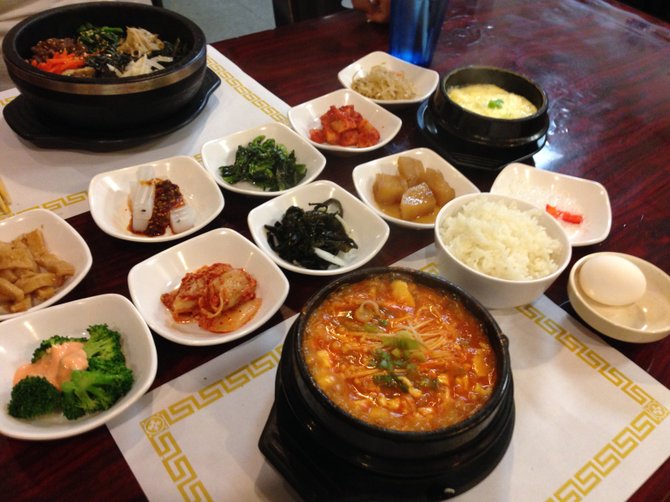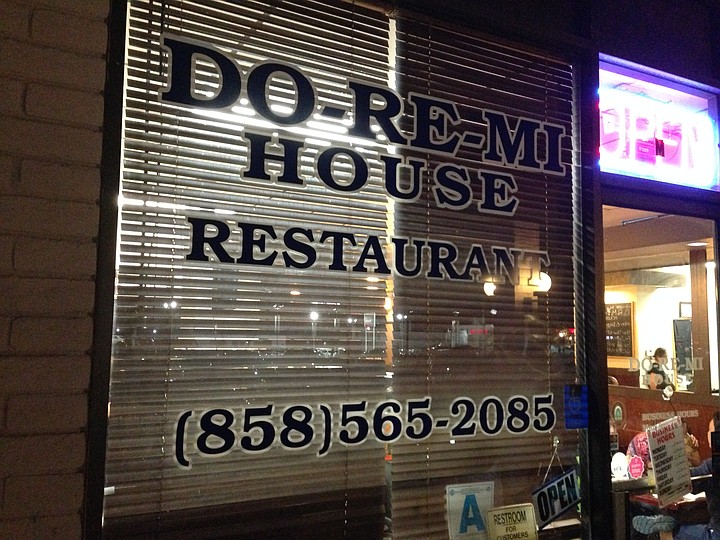 Facebook
Facebook
 X
X
 Instagram
Instagram
 TikTok
TikTok
 Youtube
Youtube


I walked into Do Re Mi House recently and ordered a dinner of hot tofu stew for about 10 bucks. It could just have easily been japchae noodles, or a hot stone bibimbap rice bowl. But really, I was there for the banchan, because Do Re Mi has the best in town. The familiar small plates started appearing at my table, and for the fifteenth time I wondered what they all were — none are listed on the menu, and some of this stuff is so far removed from Western cuisine I couldn't even tell what it was made from.
I had planned to be an annoying customer, asking my waitress "What's this?" and "How do you pronounce that?" But she shot me down from the start, too busy and exasperated to give a damn about my fluttering, blue, inquisitive eyes. Which is why I've had to do a little independent research to identify (correctly I hope) some of my favorite banchan dishes.
I'll start with the simplest stuff. The kimchi cabbage was easy to identify, with its spicy pickling and red sauce. So was the kongnamul — boiled and seasoned mung bean sprouts. I enjoy them both, though I don't want to give the impression they're remotely alike, as I know a lot of people have an aversion to kimchi, and the relatively mild, almost nutty flavors of the sprouts swing widely in the opposite direction.
In fact, while a few of these dishes resemble one another in look, they rarely do in taste. Gamja jorim consists of sweetly braised chunks of potato, which are soft and moist, and usually the first to go when I eat here with friends. Covered with a red paste, ggakdugi looks like a spicier version of the potato dish, but it's actually another kimchi, made with radish. Though not an intentional bait and switch, the crunch of the radish can shock your senses, while probably clearing your sinuses.
I couldn't find a Korean term to name the small broccoli dish with the vaguely orange colored sauce, but it tastes like steamed broccoli with a savory, almost creamy dressing. The braised spinach sigeumchi also lives up to its appearance, with a satisfying saltiness, though the similar looking seaweed miyeok takes a bitter turn. Part of the joy of sifting through these disparate dishes is in bouncing from flavor to flavor, reveling in the complexity of one, the simplicity of the next, and the confounding nature of the one after that.
I got a little confused trying to pin down the name of the fish cake strips, which come off as slightly tangy and pleasantly chewy. They're either called eomuk or odaeng, which seem to be about the same thing. But by far the toughest to ID were the two dishes I find to be the most unusual, memorable and delicious of the bunch. Cheongpomuk are pieces of jelly made from mung starch that had me thinking they were thick chunks of rice noodle — quite cool and just barely al dente, served with a mild chili paste.
Finally, cheonsachae are pickled kelp noodles, a description that doesn't do them justice. Think crystallized noodles of sweet water, glasslike in appearance and crunchy in the way raw fish is said to be crunchy, with a burst of juiciness in each bite, and just a hint of vinegar to keep them from being too candylike. It's still not something I'm used to tasting, though I'll keep going back until it is. Only, if you see me there, don't ask me how to pronounce any of these words correctly. I barely know how to say banchan out loud.



I walked into Do Re Mi House recently and ordered a dinner of hot tofu stew for about 10 bucks. It could just have easily been japchae noodles, or a hot stone bibimbap rice bowl. But really, I was there for the banchan, because Do Re Mi has the best in town. The familiar small plates started appearing at my table, and for the fifteenth time I wondered what they all were — none are listed on the menu, and some of this stuff is so far removed from Western cuisine I couldn't even tell what it was made from.
I had planned to be an annoying customer, asking my waitress "What's this?" and "How do you pronounce that?" But she shot me down from the start, too busy and exasperated to give a damn about my fluttering, blue, inquisitive eyes. Which is why I've had to do a little independent research to identify (correctly I hope) some of my favorite banchan dishes.
I'll start with the simplest stuff. The kimchi cabbage was easy to identify, with its spicy pickling and red sauce. So was the kongnamul — boiled and seasoned mung bean sprouts. I enjoy them both, though I don't want to give the impression they're remotely alike, as I know a lot of people have an aversion to kimchi, and the relatively mild, almost nutty flavors of the sprouts swing widely in the opposite direction.
In fact, while a few of these dishes resemble one another in look, they rarely do in taste. Gamja jorim consists of sweetly braised chunks of potato, which are soft and moist, and usually the first to go when I eat here with friends. Covered with a red paste, ggakdugi looks like a spicier version of the potato dish, but it's actually another kimchi, made with radish. Though not an intentional bait and switch, the crunch of the radish can shock your senses, while probably clearing your sinuses.
I couldn't find a Korean term to name the small broccoli dish with the vaguely orange colored sauce, but it tastes like steamed broccoli with a savory, almost creamy dressing. The braised spinach sigeumchi also lives up to its appearance, with a satisfying saltiness, though the similar looking seaweed miyeok takes a bitter turn. Part of the joy of sifting through these disparate dishes is in bouncing from flavor to flavor, reveling in the complexity of one, the simplicity of the next, and the confounding nature of the one after that.
I got a little confused trying to pin down the name of the fish cake strips, which come off as slightly tangy and pleasantly chewy. They're either called eomuk or odaeng, which seem to be about the same thing. But by far the toughest to ID were the two dishes I find to be the most unusual, memorable and delicious of the bunch. Cheongpomuk are pieces of jelly made from mung starch that had me thinking they were thick chunks of rice noodle — quite cool and just barely al dente, served with a mild chili paste.
Finally, cheonsachae are pickled kelp noodles, a description that doesn't do them justice. Think crystallized noodles of sweet water, glasslike in appearance and crunchy in the way raw fish is said to be crunchy, with a burst of juiciness in each bite, and just a hint of vinegar to keep them from being too candylike. It's still not something I'm used to tasting, though I'll keep going back until it is. Only, if you see me there, don't ask me how to pronounce any of these words correctly. I barely know how to say banchan out loud.
Comments